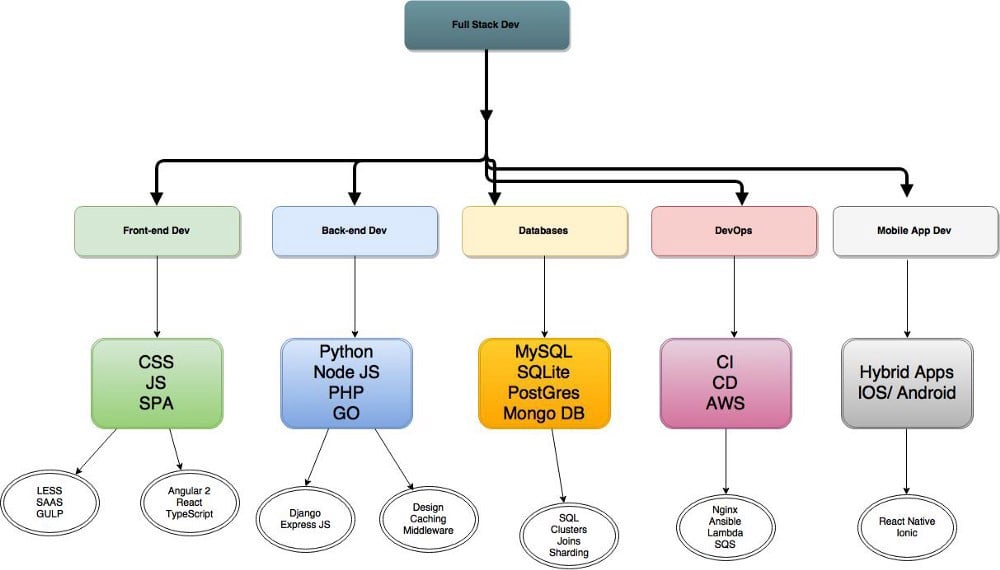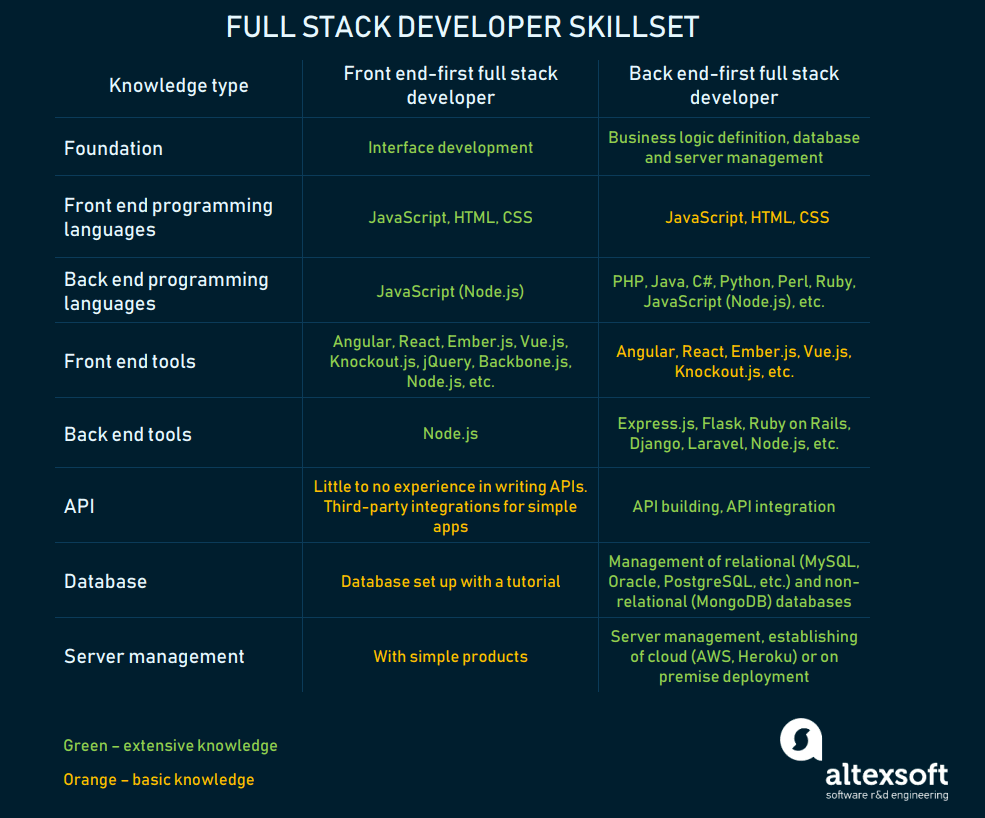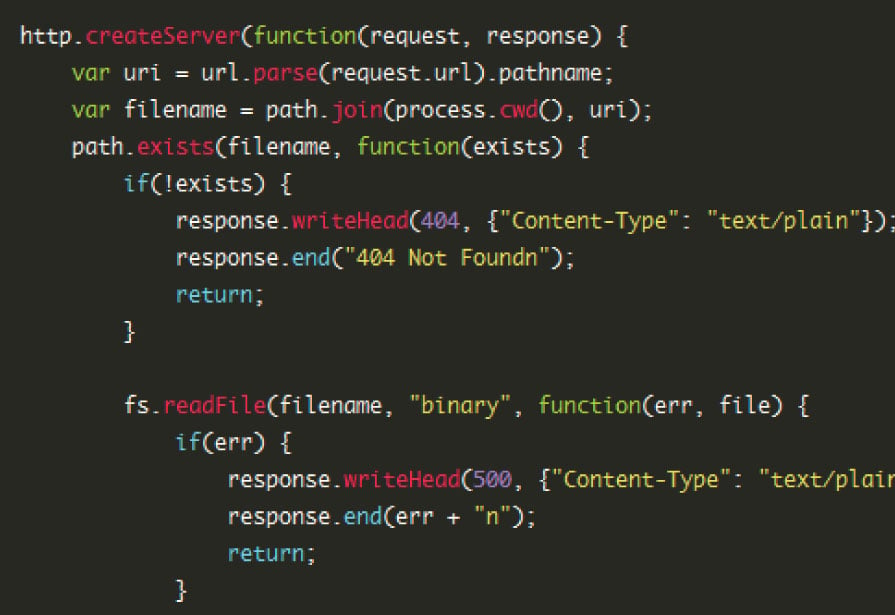Full-stack development and software engineering are two popular job titles within the software industry. Although the two share certain approaches and tools of the trade, they are distinct roles that come with different responsibilities.
If you’ve wondered about what makes full-stack developers different from software engineers, read on. We’re going to cover what sets these two fields apart, how their respective development processes differ, the programming languages that each use, and their common responsibilities on a development team.
What’s the Difference Between a Full-Stack Developer and a Software Engineer?
A full-stack web developer is someone who builds both the front-end and back-end of a website. Front-end development involves building the user interface of websites, while back-end development entails back-end operations like the server and database of a website. Full-stack developers have the technical skills to work on both aspects of a project.
A software engineer, on the other hand, is somebody who builds software to be used natively on desktops, mobile, television sets, and other devices. It is a field that relies heavily on computer science and mathematical techniques, which isn’t always the case with full-stack development.
A full-stack developer focuses mainly on the requirements of the website being built and the browsers it’s going to run on. Software engineers have to think a lot more about the environment where the software is going to run. They need to have extensive knowledge of things like operating systems, the native application stack, software engineering principles, and design.


Become a Software Engineer. Land a Job or Your Money Back.
Code in the industry's most widely used programming languages. Test your knowledge through job-ready projects. Work 1:1 with an industry mentor. Land a job — or your money back.
Full-Stack Development vs. Software Engineering
Now that we have a basic understanding of what constitutes full-stack development and software engineering, let’s examine the tools, skills, and career paths associated with each discipline.
What Does Each Mean?
What Is Full-Stack Development?

A full-stack developer is someone who builds both the front-end operations and back-end operations for a website. It used to be that front-end web developers would build the user interface of the website and the back-end developer would build the server-side applications.
But that soon changed when developers who could do both emerged. These are professionals who can work on client-side development, which means that they understand how to design and structure the website. Along with that, they’re also able to construct the internal architectures of the site. That includes the server where the website is hosted and the database to store and retrieve data.
The modern full-stack developer is a highly versatile software professional. Businesses value them for their ability to quickly build minimum viable products and enhance the application iteratively. While some full-stack developers work in collaborative environments, most work independently and take on various development tasks depending on the demands of the project.
What Is Software Engineering?
Software engineering is a field that concerns itself with the process of designing and building software applications based on the requirements of a user. It also provides a set of frameworks and approaches that practitioners can use to build effective software solutions.
Software engineering is a field that in many ways has a much larger scope than full-stack development. At a theoretical level, it combines knowledge from various fields, including computer science, mathematics, design, and management. Full-stack developers don’t need to be as familiar with areas like computer science and math as software engineers do.
Software engineering has many sub-disciplines within it. It covers areas such as software project management, software testing, requirement engineering, and software design. Due to the broad scope of projects, software engineers usually work in highly collaborative environments where large teams build components of a piece of software which are then integrated into the final stages of the project.
Goals and Purpose
What Is the Goal of Full-Stack Development?
The goal of full-stack development is to build websites from end to end. That includes designing the front-end, building the back-end, and setting up the database to communicate with both those other components in an accurate manner.
What Is the Goal of Software Engineering?
The goal of software engineering is to build high-performance software applications that are highly reliable, easy to maintain, and capable of being reused. Software engineers need to take the environment where the software will run into account when building it for that reason. That means that it should be developed in a way that corresponds to the requirements of the device, operating system, and platform on which it will run.
Get To Know Other Software Engineering Students
Tetyana Ilyichova
Software Engineering Apprentice at Affirm
Kristy Chu
Software Engineer at FloQast
Elena Nurullina
Junior Web Developer at G/O Media
Full-Stack Developer vs. Software Engineer
Now let’s take a look at the differences between full-stack developers and software engineers based on their responsibilities, skills, and tools that they use.
Job Description
What Does a Full-Stack Developer Do?

A full-stack developer is somebody who knows how to work in both front-end and back-end development. This means that they are able to build entire websites end to end without having to rely on other resources.
Here are the roles are and responsibilities of a full-stack developer:
- Study and analyze the briefs for each website development project
- Design the architecture of the project as a blueprint for the client-side and server-side development process
- Design and code the front-end of the website in adherence with UX design principles
- Construct a database management system based on the requirements of the project
- Choose APIs and study their documentation to source data for the project
- Work as a backend developer to set up the server for the website and connect it to the client-side application
- Test and troubleshoot the website
- Write any documentation required for the maintenance of the website
What Does a Software Engineer Do?
Software engineers are trained in building software products of many different kinds, including native desktop programs, games, and networking systems. They do so by using their knowledge of domains such as computer science, math, and project management.
Here are the roles and responsibilities of a software engineer:
- Create a requirements specification for each project based on the client brief
- Analyze the requirements of the project and determine its environmental constraints (operating system, device, etc)
- Conceptualize the architecture of the software system and produce a system design
- Choose appropriate programming languages, APIs, and tools for the project
- Code the software in phases based on the software development lifecycle
- Carry out a risk and reliability analysis of the system
- Carry out software testing and debug any faulty elements
Skills & Requirements
What Are the Requirements to Become a Full-Stack Developer?
You need to be a good front-end developer and back-end developer to work in full-stack development.
For front-end projects, you need to understand the basic principles of good web design and be able to produce wireframes.
Once you have the design ideation done, you move on to creating the design. Front-end developers use HTML, CSS, and Javascript to design how websites look and behave.
When it comes to the server-side development phase, it helps to understand the Linux environment. Server technologies like Apache are often run on Linux so it helps if you are familiar with the operating system.
Finally, there’s the database component. As a full-stack developer, you should have a good understanding of various database technologies like Oracle, MongoDB, and MySQL. You should also be adept at integrating the database and server to communicate with each other in a high-fidelity manner.
What Are the Requirements To Be a Software Engineer?
Software engineers usually have a strong background in computer science. You don’t necessarily need to go to college to learn computer science for software engineering. Software engineering bootcamps can teach you the fundamentals of software engineering in just a few months.
The main thing is that you should be familiar with concepts in computer science like algorithms, data structures, computer organization, and networks. These are all things that you will use in your work as a software engineer.
It also helps to have some foundational math skills when you work in software engineering. So make sure that you spend some time wrapping your head around topics such as discrete mathematics, linear algebra, and some basic calculus.
Of course, you do need programming chops if you’re going to work in software engineering. C++, Python, and Java are some of the programming languages commonly used in the field. Start by learning one language and using it to build projects. Move on to other languages only after you have a strong grounding in one. This is because a lot of the knowledge that you pick up in one programming language will transfer well to the other ones you decide to learn.
Related Read: How To Become a Software Engineer
Languages & Tools
Both software engineering and full-stack development have their own sets of languages and tools that they use most often. Let’s break it down.
Full-Stack Developer Languages
These are the libraries and frameworks that full-stack developers use most often:
- HTML

HTML stands for Hypertext Markup Language. It is a markup language that is used to communicate the structure of a website to a browser.
- CSS

CSS stands for Cascading Style Sheet. It is a language used to style the elements on a webpage. Things like the colors of different elements and font styles are set using CSS.
- Javascript

Javascript is used to give web elements dynamic behavior. Whenever you see a button change when you hover over it or any animated elements on a website, there’s usually Javascript code running in the background.
- Python

Python is a relatively new programming language for front-end development. It is a user-friendly language with a syntax that’s easy to learn.
Full-Stack Developer Libraries and Frameworks
Here are the libraries and frameworks that full-stack developers use most often:
- Mustache


Mustache provides templates that you can use to speed up your web design process.
- EJS

Embedded Javascript Templates (EJS) allow you to generate HTML from Javascript code.
- Svelte

Svelte is a compiler for generating optimized Javascript code for web interfaces.
- Next.js

This is a web development framework that makes developing websites a lot more streamlined. It is built on top of Node.js.
- Semantic UI

Semantic UI comes with pre-designed templates that can be used to create responsive HTML pages.
- MongoDB

MongoDB is an open-source database technology that you can use to build highly scalable database systems.
Software Engineer Languages
Here are the programming languages that software engineers use most frequently:
- Java

Java is a powerful cross-platform object-oriented programming language. It is used to program software for all kinds of device types.
- Python

Python is also used by software engineers thanks to features that support complex computation and cross-platform compatibility.
- C++

C++ is an object-oriented programming language that’s used to program everything from operating systems to embedded software in cars.
- Swift

Swift is Apple’s programming language for its own ecosystem. Any software engineers who want to build applications for Apple TV, Mac, Apple Watch, and other Apple devices need to learn how to program in Swift.
Software Engineer Libraries and Frameworks
If you want to work in software engineering, you should be familiar with these libraries and frameworks.
- NodeJS

NodeJS can be used to build non-blocking servers for any software that requires that backend component.
- Angular JS

AngularJS is used to develop dynamic applications on the Internet. It extends HTML syntax so that you can define the components of your application succinctly.
- TensorFlow

TensorFlow is a library with a lot of functions that support machine learning and artificial intelligence applications.
- React

React is a great tool to use to create component-based interactive user interfaces.
- Spring

If you work in Java development, then you can use the open-source Spring framework for infrastructure support in your projects.
- Django

Django is a framework for rapid development in the Python programming language.
Salary
How Much Can a Full-Stack Developer Make?

The average salary of a full-stack developer in the United States is $100,795.
How Much Can a Software Engineer Make?

Software engineers have an average annual salary of $127,200.
Career Paths
Though both roles lead to a development team, the path to becoming a software engineer varies from the path to becoming a full-stack developer.
What’s a Typical Career Path for a Full-Stack Developer?
It is very rare that anybody starts their career off as a full-stack developer. It is more common to first start off as either a front-end developer or a back-end developer. That gives you the opportunity to build a strong foundation in a single discipline.
It is only after that that some developers begin to pick up complementary skills in either front-end or back-end development. You can go about picking up new skills on your own using sites like YouTube or with the help of a full-stack development bootcamp.
If you already have a job as a web developer, then you can apply for a full-stack role within your company. But you also have the option of building out your portfolio with your own projects and applying to companies thereafter.
What’s a Typical Career Path for a Software Engineer
Software engineers typically start their journey as junior engineers working within a specific programming language. So they might start their career off as a junior Java or C++ engineer, then move on to a senior engineer role after three to five years of experience.
From here, software engineers can go one of two ways. They can become a lead developer, which means that they continue to write code as a software engineer but also oversee a group of younger engineers. The other option is to work as a technical architect, which doesn’t require as much coding and instead involves creating the blueprint for software systems that the engineers can then execute.
If you like managing people, then you will be able to move on to becoming a software engineering manager with eight to ten years of experience. This is a role that will involve leading a team and ensuring that they’re able to deliver projects on time.
There are some software engineers who prefer to remain in a technical role. In that case, you can choose to become a development team lead. This is also a managerial role but one where you will have to provide technical leadership along with managing the output of your team.
How To Choose Between a Full-Stack Developer and Software Engineer Career
Here’s how you can go about deciding whether you’re better suited for a full-stack developer or software engineer career.
Your Education and Experience
Software engineers are a lot more likely to come from conventional college education backgrounds. The job usually requires a four-year degree in a computer science or math discipline. So if you’ve got that under your belt then you’ll have an easier time landing a software engineering job.
Full-stack development roles are a lot easier to land without a college degree. Recruiters mainly want to see your portfolio so that they can make sure that you have the required full-stack development skills. If you’re self-taught, then make sure that you work on your own projects and build a strong portfolio.
Your Interests
Full-stack development is a role that’s geared towards people who like working independently. You will have the freedom to shape the progress of projects on your own and report to team members only at milestone points in the project.
Software engineering, on the other hand, is a more collaborative job. You will be in constant contact with managers, technical team leads, and other stakeholders when you work as a software engineer. So choose this career if you enjoy working in highly collaborative environments.
Your Career Goals
Consider a Full-Stack Developer Career If…
You enjoy web programming and the process of seeing a website development project through. It is an area that is constantly evolving and you will get to work with some very exciting startups and companies.
Consider a Software Engineer Career If…
You want to work in a multi-disciplinary field that will test your knowledge of math, computer science, and engineering principles equally. It is a demanding job but one where you will get to build large-scale products across many different kinds of devices and platforms.
Since you’re here…
Were you one of the tens of thousands of workers impacted by this year’s tech layoffs? Springboard wants to help. Our new Career Reboot Scholarship is intended to assist job seekers from tech looking to upskill, reskill and stand out in a competitive hiring environment. Get $1,000 off any Springboard bootcamp in software engineering, data analytics, UX design, cybersecurity, tech sales, and more. Visit this page for eligibility requirements and to apply.






![Awesome Software Engineering Resumes [+ Tips & Templates]](https://www.springboard.com/blog/wp-content/uploads/2021/05/shutterstock_579082669-scaled-380x235.jpg)
